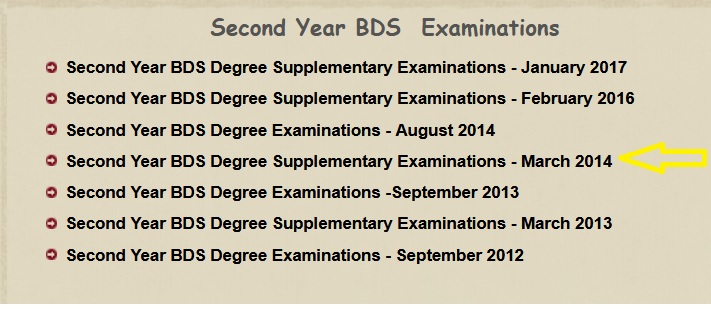General & Dental Pharmacology And Therapeutics BDS Question Paper : kuhs.ac.in
Name of the University : Kerala University of Health Sciences
Degree : BDS
Subject Name : General & Dental Pharmacology And Therapeutics
Year : II
Document Type : Model Question Paper
Website : kuhs.ac.in
Download Model/Sample Question Paper :
September 2013 : https://www.pdfquestion.in/uploads/kuhs.ac.in/3441-1-GENERAL%20&%20DENTAL%20PHARMACOLOGY%20AND%20THERAPEUTICS.pdf
September 2012 : https://www.pdfquestion.in/uploads/kuhs.ac.in/3441-2-GENERAL%20&%20DENTAL%20PHARMACOLOGY%20AND%20THERAPEUTICS.pdf
March 2013 : https://www.pdfquestion.in/uploads/kuhs.ac.in/3441-3-3GENERAL%20&%20DENTAL%20PHARMACOLOGY%20AND%20THERAPEUTICS.pdf
KUHS General & Dental Pharmacology Question Paper
Second Year BDS Degree Examinations -September 2013
GENERAL & DENTAL PHARMACOLOGY AND THERAPEUTICS :
Time: 3 hrs
Max marks: 100
Related / Similar Question Paper :
KUHS BDS General Human Anatomy Question Paper
Answer all questions :
Draw diagram wherever necessary :
Essay : (2×14=28)
1. Classify non-steroidal anti-inflammatory drugs. Explain its therapeutically useful action. Add a note on its adverse effects (5+6+3)
2. Classify drugs used in angina pectoris with examples. Explain the mechanism of action of each of the groups of drugs. Outline the treatment of acute angina pectoris (4+8+2)

Short essays : (4×8=32)
3. Classify drugs used in acid peptic diseases with examples. Write the mode of action & adverse effects of one drug from any group. (4+4)
4. Enumerate sulfonylureas. Explain its mechanism of action and adverse effects (2+3+3)
5. Explain four clinical uses of diazepam
6. Classify drugs used in acid peptic diseases with examples
Short notes : (10×4=40)
7. Uses and adverse effects of ampicillin
8. Low molecular weight heparin
9. Advantages and disadvantages of intravenous route of drug administration
10. Name four alpha adrenoceptor antagonists and its uses
11. Explain the mechanism of action and uses of cromolyn sodium
12. Enumerate the first line drugs used in tuberculosis and a characteristic adverse effect for each drug
13. Name four fluoroquinolones and mention the indications and adverse effects for any one
14. Name two anti caries agents and explain its mechanism of action
15. Enumerate the adverse effects of furosemide
16. Enlist the advantages of atypical antipsychotics over chlorpromazine
September 2012
Time: 3 hrs
Max marks: 100
Answer all questions :
Draw diagram wherever necessary :
Essay : (2×14=28)
1. Classify non-steroidal anti-inflammatory drugs. Describe the mechanism of action, uses and adverse effects of aspirin. (5+2+4+3).
2. Classify anticholinergic drugs. Discuss the therapeutic uses and adverse effects of atropine. (4+7 +3).
Short essays : (4×8=32)
3. Drug antagonism
4. Pre anaesthetic medication
5. Uses and adverse effects of ACE inhibitors
6. Iron preparations
Short notes : (10×4=40)
7. Classify oral hypoglycaemic agents
8. Antimicrobial prophylaxis in dentistry
9. Anti platelet drugs
10. Uses and adverse effects of metoclopramide
11. Merits and demerits of Oral route of drug administration
12. Uses of ethyl alcohol.
13. Outline the general properties of aminoglycoside antibiotics
14. Drugs for the treatment of leprosy
15. Chronic fluoride toxicity
16. Teratogenicity

March 2013
Time: 3 hrs
Max marks: 100
Answer all questions :
Draw diagram wherever necessary :
Essay : (2×14=28)
1. Classify non-steroidal anti-inflammatory drugs. Mention the mechanism of action, adverse effects, and therapeutic uses of aspirin. (5+3+3+3)
2. Classify fluoroquinolones. Enumerate the mechanism of action, adverse effects, and therapeutic uses of ciprofloxacin. (5+3+3+3)
Short essays : (4×8=32)
3. Classify the local anaesthetics. Explain the mechanism of action of lignocaine (5+3)
4. Classify diuretics and mention the mechanism of action of loop diuretics (5+3)
5. Classify oral hypoglycaemic agents. Mention the mechanism of action and adverse effects of glibenclamide. (5+3)
6. Classify antiseptics and mention its therapeutic applications. (5+3)
Short notes : (10×4=40)
7. Therapeutic uses and adverse effects of digoxin.
8. Therapeutic uses and contraindications of adrenaline.
9. Intravenous general anesthetics
10. Explain briefly about the drugs used in helicobacter pylori therapy
11. Oral iron preparations
12. Mention four calcium channel blockers and its therapeutic uses
13. Explain about the local haemostatics
14. Explain the therapeutic uses of cotrimoxazole
15. Explain briefly on dentifrices
16. Mention the drugs used in insomnia and explain the mechanism of action .
March 2014
Essay : (2×14=28)
1. Discuss the factors modifying drug actions.
2. Classify opioid analgesics. Discuss the uses, adverse effects and contra-indications of morphine. (5+3+3+3)
Short essays : (4×8=32)
3. Atropine substitutes
4. Intravenous anesthetics
5. Uses and adverse effects of tetracyclines
6. Uses and adverse effects of glucocorticoids
Short notes : (10×4=40)
7. Disclosing agents in dentistry
8. Pharmacotherapy of status asthmaticus
9. Uses and adverse effects of diazepam
10. Antiseptic mouthwashes
11. Styptics
12. Uses and adverse effects of methotrexate
13. Merits and demerits of sublingual route of drug administration
14. Uses of nitrates
15. Non sedative antihistaminics.
16. Uses of thiazide diuretics
August 2014
Essay (2×14=28)
1. Explain the various factors which modify drug action and its therapeutic applications.
2. Classify beta lactam antibiotics . Explain the mechanism of action, adverse effects and therapeutic uses of amoxycillin. (5+3+3+3)
Short essays :
3. Classify the drugs used in bronchial asthma and briefly explain inhalation corticosteroids. (5+3)
4. Classify anti malarial drugs and the explain about chloroquine (5+3)
5. Classify general anesthetics. Mention the mechanism of action and adverse effects of inhalational anesthetics. (4+2+2)
6. Enumerate the anticoagulants. Explain the mechanism of action and therapeutic uses of heparin (3+3+2)
Short notes :
7. Second generation antihistamines
8. Mention four proton pump inhibitors and its uses
9. Explain briefly about selective COX-2 inhibitors and its side effects
10. Mention four sulfonyl ureas and its mechanism of action
11. Uses and adverse effects of adrenaline
12. Explain briefly on ACE inhibitors
13. Uses and adverse effects of methotrexate
14. Mention the therapeutic uses and adverse effects of metronidazole
15. Uses of diazepam
16. Disclosing agents